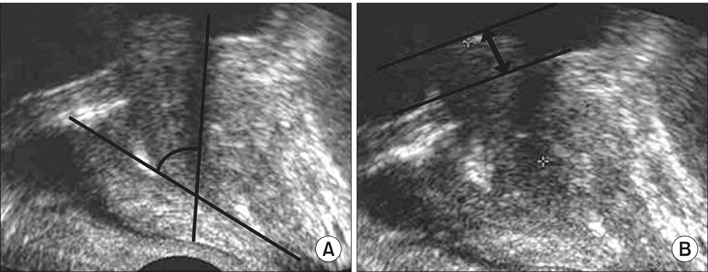Korean J Urol.
2012 Jun;53(6):410-413.
Is Increased Prostatic Urethral Angle Related to Lower Urinary Tract Symptoms in Males with Benign Prostatic Hyperplasia/Lower Urinary Tract Symptoms?
- Affiliations
-
- 1Department of Urology, Catholic University of Daegu, School of Medicine, Daegu, Korea. jspark@cu.ac.kr
Abstract
- PURPOSE
The prostatic urethra is a bent tube, and the clinical significance of the prostatic urethral angle (PUA) was recently reported. We investigated the statistical significance of an increased PUA on the International Prostate Symptom Score (IPSS) in men with benign prostatic hyperplasia (BPH)/lower urinary tract symptom (LUTS).
MATERIALS AND METHODS
A retrospective analysis was done of 270 men with BPH/LUTS from July 2009 to June 2011. Prostate volume, PUA, and intravesical prostatic protrusion (IPP) were measured by transrectal ultrasonography (TRUS). The IPSS was analyzed separately as storage and voiding symptom score. In order to minimize the effect of prostate size on voiding, patients with prostate size over 40 ml were excluded.
RESULTS
The mean age was 62.0+/-9.3 years. The mean prostate volume was 29.0+/-5.5 ml (range, 20 to 40 ml), and median PUA and IPP were 34degrees (range, 12 to 52degrees) and 1.7 mm (range, 0 to 5.3 mm), respectively. The mean IPSS, mean IPSS-ss, and mean IPSS-vs were 19.0+/-8.2, 7.3+/-4.0, and 11.6+/-5.5, respectively. The prostate volume had no statistically significant correlation with IPSS, IPSS-ss, or IPSS-vs. IPP had a statistically significant correlation with IPSS (p<0.001), IPSS-ss (p<0.001), and IPSS-vs (p<0.001). PUA had no statistically significant correlation with IPSS or IPSS-ss. However, PUA had a significant correlation with IPSS-vs (p=0.047). Comparing a higher PUA (> or =34degrees) with a lower PUA (<34degrees), patients with a higher PUA had a higher IPSS (p=0.001) and a higher IPSS-vs (p=0.001). There was no significant difference in IPSS-ss, prostate volume, or PSA between the two groups.
CONCLUSIONS
IPP showed significantly correlated with the IPSS and voiding symptom score was affected by the PUA but not by the prostate volume. As the PUA increased, the patients' voiding symptoms worsened. Further study may be needed.
MeSH Terms
Figure
Reference
-
1. AUA Practice Guidelines Committee. AUA guideline on management of benign prostatic hyperplasia (2003). Chapter 1: Diagnosis and treatment recommendations. J Urol. 2003. 170(2 Pt 1):530–547.2. Cho KS, Kim J, Choi YD, Kim JH, Hong SJ. The overlooked cause of benign prostatic hyperplasia: prostatic urethral angulation. Med Hypotheses. 2008. 70:532–535.3. Cho KS, Kim JH, Kim DJ, Choi YD, Kim JH, Hong SJ. Relationship between prostatic urethral angle and urinary flow rate: its implication in benign prostatic hyperplasia pathogenesis. Urology. 2008. 71:858–862.4. Nose H, Foo KT, Lim KB, Yokoyama T, Ozawa H, Kumon H. Accuracy of two noninvasive methods of diagnosing bladder outlet obstruction using ultrasonography: intravesical prostatic protrusion and velocity-flow video urodynamics. Urology. 2005. 65:493–497.5. Berry SJ, Coffey DS, Walsh PC, Ewing LL. The development of human benign prostatic hyperplasia with age. J Urol. 1984. 132:474–479.6. Klingler HC, Madersbacher S, Djavan B, Schatzl G, Marberger M, Schmidbauer CP. Morbidity of the evaluation of the lower urinary tract with transurethral multichannel pressure-flow studies. J Urol. 1998. 159:191–194.7. Onur R, Ozden M, Orhan I, Kalkan A, Semercioz A. Incidence of bacteraemia after urodynamic study. J Hosp Infect. 2004. 57:241–244.8. Kuo HC. Clinical prostate score for diagnosis of bladder outlet obstruction by prostate measurements and uroflowmetry. Urology. 1999. 54:90–96.9. Keqin Z, Zhishun X, Jing Z, Haixin W, Dongqing Z, Benkang S. Clinical significance of intravesical prostatic protrusion in patients with benign prostatic enlargement. Urology. 2007. 70:1096–1099.10. Chia SJ, Heng CT, Chan SP, Foo KT. Correlation of intravesical prostatic protrusion with bladder outlet obstruction. BJU Int. 2003. 91:371–374.11. McNeal JE. The prostate and prostatic urethra: a morphologic synthesis. J Urol. 1972. 107:1008–1016.12. Ku JH, Ko DW, Cho JY, Oh SJ. Correlation between prostatic urethral angle and bladder outlet obstruction index in patients with lower urinary tract symptoms. Urology. 2010. 75:1467–1471.13. Lee JM, Chung H, Kim TW, Kim HS, Wang JH, Yang SK. The correlation of intravesical prostatic protrusion with storage symptoms, as measured by transrectal ultrasound. Korean J Urol. 2008. 49:145–149.14. Kim BH, Sohn JC, Park CH, Kim CI. The usefulness of intravesical prostatic protrusion and bladder wall thickness measurement using transabdominal ultrasound in patients with benign prostatic hyperplasia. Korean J Urol. 2005. 46:1180–1185.15. Kim KH, Kim YS. Correlation of male overactive bladder with intravesical prostatic protrusion. Korean J Urol. 2010. 51:843–846.
- Full Text Links
- Actions
-
Cited
- CITED
-
- Close
- Share
- Similar articles
-
- Current Trend of the Primary Treatment in Lower Urinary Tract Symptom/Benign Prostatic Hyperplasia
- The Urinary Tract Microbiome in Male Genitourinary Diseases: Focusing on Benign Prostate Hyperplasia and Lower Urinary Tract Symptoms
- The Relationship of Prostatic Urethral Obstruction of Cytourethroscopy with Voiding Symptoms and Prostate Volume in Lower Urinary Tract Symptoms Patients
- A Study on Physiological Index, Anxiety and Depression by the Severity of Lower Urinary Tract Symptoms in Patients with Benign Prostatic Hyperplasia
- The Relationship between Benign Prostate Hyperplasia and Erectile Dysfunction: What is Reality?


